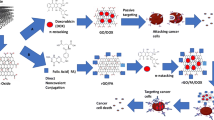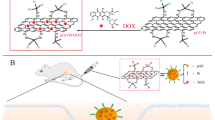Abstract
Temozolomide (TMZ) is the first-line chemotherapy for glioblastoma, a deadly brain cancer. Doxorubicin (DOX) is another cancer chemotherapeutic drug, but low blood–brain barrier permeability limits its use for glioblastoma. This limitation may be overcome using nanocarriers as new delivery strategies. This study aimed to load DOX and TMZ on cyclodextrin-graphene oxide nanocarrier and evaluate their combined cytotoxic effect against glioblastoma. The α-, β-, and γ-cyclodextrins (CDs) were separately conjugated to graphene oxide (GO) sheets to synthesize nanocarriers for TMZ and DOX. The entrapment and drug loading efficiency were determined by UV–visible spectrophotometry analysis at 480 nm for TMZ and 330 nm for DOX. The MTT assay and annexin V/PI staining were used to assess cytotoxicity of TMZ, DOX, and their nanocarriers on viability and apoptosis of U87 cells. Drug-content evaluation showed that the loading efficiency of α-, β-, and γ-CD-GO-TMZ was 29%, 31%, and 21%, respectively. The loading level for DOX was found to be 18–25%. The nanocarriers loaded with TMZ and DOX showed more cytotoxic effects against glioblastoma cells compared to the drugs used alone. Among different kinds of α-, β-, and γ-CD-GO nanocarriers, the β-CD-GO-TMZ and α-CD-GO-DOX showed better cytotoxic activity. Combination of γ-CD-GO-TMZ and γ-CD-GO-DOX exhibited a synergistic effect. Also, the drug-loaded nanocarriers were able to induce apoptosis and necrosis in glioblastoma cells. In conclusion, our findings demonstrated that formulation of TMZ and DOX using CD-GO nanocarriers may be a promising candidate for glioblastoma management.









Similar content being viewed by others
Data Availability
The data that support the findings of this study are available from the corresponding author upon reasonable request.
References
Sawosz, E., Jaworski, S., Kutwin, M., Vadalasetty, K. P., Grodzik, M., Wierzbicki, M., Kurantowicz, N., Strojny, B., Hotowy, A., & Lipińska, L. (2015). Graphene functionalized with arginine decreases the development of glioblastoma multiforme tumor in a gene-dependent manner. International journal of molecular sciences, 16(10), 25214–25233.
Walker, C., Baborie, A., Crooks, D., Wilkins, S., & Jenkinson, M. (2011). Biology, genetics and imaging of glial cell tumours. The British journal of radiology, 84(special_issue_2), 90–106.
Noch, E. K., Ramakrishna, R., & Magge, R. (2018). Challenges in the treatment of glioblastoma: Multisystem mechanisms of therapeutic resistance. World neurosurgery, 116, 505–517.
Lee, S. Y. (2016). Temozolomide resistance in glioblastoma multiforme. Genes & diseases, 3(3), 198–210.
Zhao, P.-H., Wei, Z., Wang, L.-H., Pang, C., Zhang, H.-R., Wang, J., & Wang, Y.-L. (2021). Delivery of temozolomide using PEGylated graphene oxide as a nanocarrier. Materials Express, 11(2), 189–195.
Trinh, V. A., Patel, S. P., & Hwu, W. J. (2009). The safety of temozolomide in the treatment of malignancies. Expert opinion on drug safety, 8(4), 493–499.
Xu, Y., Shen, M., Li, Y., Sun, Y., Teng, Y., Wang, Y., & Duan, Y. (2016). The synergic antitumor effects of paclitaxel and temozolomide co-loaded in mPEG-PLGA nanoparticles on glioblastoma cells. Oncotarget, 7(15), 20890.
Villodre, E. S., Kipper, F. C., Silva, A. O., Lenz, G., & Lopez, P. L. C. D. (2018). Low dose of doxorubicin potentiates the effect of temozolomide in glioblastoma cells. Molecular neurobiology, 55(5), 4185–4194.
Du, K., Xia, Q., Heng, H., & Feng, F. (2020). Temozolomide–doxorubicin conjugate as a double intercalating agent and delivery by apoferritin for glioblastoma chemotherapy. ACS applied materials & interfaces, 12(31), 34599–34609.
Lüpertz, R., Wätjen, W., Kahl, R., & Chovolou, Y. (2010). Dose-and time-dependent effects of doxorubicin on cytotoxicity, cell cycle and apoptotic cell death in human colon cancer cells. Toxicology, 271(3), 115–121.
Chowdhury, N., Chaudhry, S., Hall, N., Olverson, G., Zhang, Q.-J., Mandal, T., Dash, S., & Kundu, A. (2020). Targeted delivery of doxorubicin liposomes for Her-2+ breast cancer treatment. An Official Journal of the American Association of Pharmaceutical Scientists, 21, 1–12.
Aziz, A., Sefidbakht, Y., Rezaei, S., Kouchakzadeh, H., & Uskoković, V. (2022). Doxorubicin-loaded, pH-sensitive albumin nanoparticles for lung cancer cell targeting. Journal of Pharmaceutical Sciences, 111(4), 1187–1196.
Zhang, Z., Yu, X., Wang, Z., Wu, P., & Huang, J. (2015). Anthracyclines potentiate anti-tumor immunity: A new opportunity for chemoimmunotherapy. Cancer letters, 369(2), 331–335.
Patel, A. G., & Kaufmann, S. H. (2012). Cancer: How does doxorubicin work? eLife, 1, e00387.
Wang, B., Guo, H., Xu, H., Chen, Y., Zhao, G., & Yu, H. (2022). The role of graphene oxide nanocarriers in treating gliomas. Frontiers in oncology, 12, 176.
Einafshar, E., Asl, A. H., Nia, A. H., Mohammadi, M., Malekzadeh, A., & Ramezani, M. (2018). New cyclodextrin-based nanocarriers for drug delivery and phototherapy using an irinotecan metabolite. Carbohydrate polymers, 194, 103–110.
Taheriazam, A., Abad, G. G. Y., Hajimazdarany, S., Imani, M. H., Ziaolhagh, S., Zandieh, M. A., Bayanzadeh, S. D., Mirzaei, S., Hamblin, M. R., & Entezari, M. (2023). Graphene oxide nanoarchitectures in cancer biology: Nano-modulators of autophagy and apoptosis. Journal of Controlled Release, 354, 503–522.
Liu, J., Cui, L., & Losic, D. (2013). Graphene and graphene oxide as new nanocarriers for drug delivery applications. Acta biomaterialia, 9(12), 9243–9257.
Gurunathan, S., Kang, M.-H., Qasim, M., & Kim, J.-H. (2018). Nanoparticle-mediated combination therapy: Two-in-one approach for cancer. International journal of molecular sciences, 19(10), 3264.
Guo, X., & Mei, N. (2014). Assessment of the toxic potential of graphene family nanomaterials. Journal of food and drug analysis, 22(1), 105–115.
Jaworski, S., Sawosz, E., Kutwin, M., Wierzbicki, M., Hinzmann, M., Grodzik, M., Winnicka, A., Lipińska, L., Włodyga, K., & Chwalibog, A. (2015). In vitro and in vivo effects of graphene oxide and reduced graphene oxide on glioblastoma. International journal of nanomedicine, 10, 1585.
Gürten, B., Yenigül, E., Sezer, A. D., & Malta, S. (2018). Complexation and enhancement of temozolomide solubility with cyclodextrins. Brazilian Journal of Pharmaceutical Sciences, 54.
Einafshar, E., HaghighiAsl, A., Ramezani, M., Hashemnia, A., & Malekzadeh, A. (2019). Synthesis and characterization of multifunctional graphene oxide with gamma-cyclodextrin and SPION as new nanocarriers for drug delivery. Applied Chemistry, 14(51), 35–50.
Einafshar, E., Khodadadipoor, Z., Nejabat, M., & Ramezani, M. (2021). Synthesis, Characterization and application of α, β, and γ cyclodextrin-conjugated graphene oxide for removing cadmium ions from aqueous media. Journal of Polymers and the Environment, 29, 3161–3173.
Einafshar, E., HaghighiAsl, A., & Malekzadeh, A. (2018). Synthesis of new biodegradable nanocarriers for SN38 delivery and synergistic phototherapy. Nanomed J, 5(4), 210–216.
Najafi, Z., Einafshar, E., Mirzavi, F., Amiri, H., Jalili-Nik, M., & Soukhtanloo, M. (2023). Protective effect of hesperidin-loaded selenium nanoparticles stabilized by chitosan on glutamate-induced toxicity in PC12 cells. Journal of Nanoparticle Research, 25(9), 178.
D’Souza, S. (2014). A review of in vitro drug release test methods for nano-sized dosage forms. Advances in Pharmaceutics, 2014, 1–12.
Kim, Y., Park, E. J., Kim, T. W., & Na, D. H. (2021). Recent progress in drug release testing methods of biopolymeric particulate system. Pharmaceutics, 13(8), 1313.
Wang, B., Guo, H., Xu, H., Chen, Y., Zhao, G., & Yu, H. (2022). The role of graphene oxide nanocarriers in treating gliomas. Frontiers in Oncology, 12, 736177.
Bansal, R., Singh, R., & Kaur, K. (2021). Quantitative analysis of doxorubicin hydrochloride and arterolane maleate by mid IR spectroscopy using transmission and reflectance modes. BMC chemistry, 15(1), 1–11.
Palai, P. K., Mondal, A., Chakraborti, C. K., Banerjee, I., & Pal, K. (2019). Green synthesized amino-PEGylated silver decorated graphene nanoplatform as a tumor-targeted controlled drug delivery system. SN Applied Sciences, 1(3), 1–18.
Martinho, O., Vilaça, N., Castro, P. J., Amorim, R., Fonseca, A. M., Baltazar, F., Reis, R. M., & Neves, I. C. (2015). In vitro and in vivo studies of temozolomide loading in zeolite structures as drug delivery systems for glioblastoma. RSC Advances, 5(36), 28219–28227.
Almoshari, Y., Iqbal, H., Razzaq, A., Ali Ahmad, K., Khan, M. K., Saeed Alqahtani, S., Hadi Sultan, M., & Ali Khan, B. (2022). Development of nanocubosomes co-loaded with dual anticancer agents curcumin and temozolomide for effective Colon cancer therapy. Drug Delivery, 29(1), 2633–2643.
Wen, P., Gong, P., Mi, Y., Wang, J., & Yang, S. (2014). Scalable fabrication of high quality graphene by exfoliation of edge sulfonated graphite for supercapacitor application. RSC advances, 4(68), 35914–35918.
Zhang, P., Chen, D., Li, L., & Sun, K. (2022). Charge reversal nano-systems for tumor therapy. Journal of Nanobiotechnology, 20, 1–27.
Song, M.-M., Xu, H.-L., Liang, J.-X., Xiang, H.-H., Liu, R., & Shen, Y.-X. (2017). Lactoferrin modified graphene oxide iron oxide nanocomposite for glioma-targeted drug delivery. Materials Science and Engineering: C, 77, 904–911.
Baloi, C., Oprita, A., Semenescu, L. E., Tache, D. E., Popescu, O. S., Staicu, G. A., & Dricu, A. (2022). Combined effects of doxorubicin and temozolomide in cultured glioblastoma cells. Current Health Sciences Journal, 48(3), 263.
Horescu, C., Elena Cioc, C., Tuta, C., Sevastre, A.-S., Tache, D. E., Alexandru, O., Artene, S.-A., Danoiu, S., Dricu, A., & StefanaOana, P. (2020). The effect of temozolomide in combination with doxorubicin in glioblastoma cells in vitro. Journal of Immunoassay and Immunochemistry, 41(6), 1033–1043.
Funding
This study was supported by a research grant from the National Institutes for Medical Research Development (NIMAD), Tehran, Iran.
Author information
Authors and Affiliations
Contributions
Elham Einafshar conducted the experiments, analyzed the data, and wrote the manuscript; , Maryam Hashemi, Aida Gholoobi and Leila Mobasheri participated in the experiments and data analysis; Ahmad Ghorbani designed and supervised the research and reviewed the manuscript. All authors read and agreed with the published version of the manuscript.
Corresponding author
Ethics declarations
Competing interests
The authors declare no competing interests.
Informed Consent
Not applicable.
Conflict of Interest
None.
Research Involving Humans and Animals Statement
None.
Additional information
Publisher's Note
Springer Nature remains neutral with regard to jurisdictional claims in published maps and institutional affiliations.
Rights and permissions
Springer Nature or its licensor (e.g. a society or other partner) holds exclusive rights to this article under a publishing agreement with the author(s) or other rightsholder(s); author self-archiving of the accepted manuscript version of this article is solely governed by the terms of such publishing agreement and applicable law.
About this article
Cite this article
Einafshar, E., Hashemi, M., Gholoobi, A. et al. Temozolomide and Doxorubicin Combined Treatment by Graphene Oxide-Cyclodextrin Nanocarriers for Synergistic Inhibition of Glioblastoma Cells. BioNanoSci. (2024). https://doi.org/10.1007/s12668-024-01299-y
Accepted:
Published:
DOI: https://doi.org/10.1007/s12668-024-01299-y




